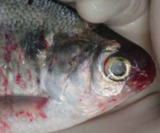- Cryptobia
-
Cryptobia Scientific classification Domain: Eukaryota (unranked): Excavata Phylum: Protozoa Class: Kinetoplastida Family: Cryptobiidae Genus: Cryptobia Species Cryptobia branchialis
Cryptobia iubilans
Cryptobia salmositica
Cryptobia bullocki
Cryptobia borreliContents
Introduction
Cryptobia species are protozoa that can lead to disease in fish. C. branchialis is an ectoparasite that lives on the skin or gills of fish, and the other four pathogenic species are endoparasites that live in the circulatory system or intestines.
Marine and freshwater fish can be infected and the disease is most important in salmonid fish. The disease is observed in most continents including the USA, Eastern Europe and Mexico.
Bloodfeeding leeches are implicated in the transmission of the disease for those species that reside in the bloodstream.
Clinical Signs and Diagnosis
C. branchialis infects the gills and can lead to skin changes, anorexia and death.
C. iubilans resides in the intestines and leads to granulomatous inflammation in the abdominal organs resulting in weight loss and death.
C. salmositica, C. borreli and C. bullocki are all blood parasites that lead to anaemia and lesions in the haematopoietic tissues.
Skin or gill biopsies and blood samples can be examined for moving flagellated organisms.
An antibody response can be detected with ELISA testing and fluorescent antibody testing for certain Cryptobia species.
Treatment and Control
Chemical treatment has been effective using isometamidium chloride.
A vaccine against C. salmositica is available and lasts up to 2 years.
Fish can be selected and bred for resistance as a method of control of the disease.
References
- Cryptobiosis, expert reviewed and published by Wikivet at http://en.wikivet.net/Cryptobiosis accessed 06/10/2011.
Pathogens - Aeromonas salmonicida
- Columnaris
- Enteric redmouth
- Fin rot
- Fish dropsy
- Flavobacterium
- Hematopoietic necrosis
- Heterosigma akashiwo
- Hole in the head
- Hypodermal and hematopoietic necrosis
- Infectious pancreatic necrosis
- Koi herpes virus
- Novirhabdovirus
- Pfiesteria piscicida
- Photobacterium damselae ssp piscicida
- Salmon anemia
- Streptococcus iniae
- Taura syndrome
- UDN
- VHS
- White spot
- Yellowhead

Parasites - Abergasilus
- Amoebic gill disease
- Carp lice
- Ceratomyxa shasta
- Dactylogyrus vastator
- Diphyllobothrium
- Epizootic ulcerative syndrome
- Flukes
- Glugea
- Gyrodactylus salaris
- Henneguya zschokkei
- Ich (freshwater)
- Ich (marine)
- Kudoa thyrsites
- Lernaeocera branchialis
- Myxobolus cerebralis
- Nanophyetus salmincola
- Salmon lice
- Saprolegnia
- Schistocephalus solidus
- Sea louse
- Sphaerothecum destruens
- Swim bladder disease
- Tetracapsuloides bryosalmonae
- Velvet
Related topics 
This veterinary medicine–related article is a stub. You can help Wikipedia by expanding it. - Cryptobiosis, expert reviewed and published by Wikivet at http://en.wikivet.net/Cryptobiosis accessed 06/10/2011.
